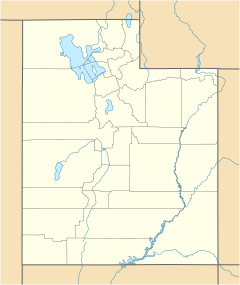Diamond, Utah facts for kids
Quick facts for kids
Diamond, Utah
|
|
|---|---|
| Country | United States |
| State | Utah |
| County | Juab |
| Settled | 1870 |
| Named for | Quartz crystals found in the area (originally thought to be diamonds) |
| Elevation | 6,253 ft (1,906 m) |
| Time zone | UTC-7 (Mountain (MST)) |
| • Summer (DST) | UTC-6 (MDT) |
| GNIS feature ID | 1455093 |
|
Diamond Cemetery
|
|
| Location | Diamond, Utah United States |
| Area | 0.25 acres (0.10 ha) |
| NRHP reference No. | 79003474 |
| Added to NRHP | March 14, 1979 |
Diamond is a ghost town located in eastern Juab County, Utah, in the United States. A ghost town is a place where people used to live and work, but now very few or no one lives there. The Diamond Cemetery is a special place from this town. It is listed on the National Register of Historic Places. This means it is an important historical site.
What Was Diamond Like?
The area where Diamond used to be is near Diamond Gulch. This is on the western side of the East Tintic Mountains. It's about 5 miles (8 km) south of Eureka. Many old mines are in the area. Diamond was part of the Tintic Mining District. This was a big area for mining.
The town got its name because people found shiny quartz crystals there. They thought these crystals were diamonds!
Diamond's History
Diamond was first settled in 1870. This was after people found the "diamonds" in the area. Soon, the town grew. It had a post office, stores, and even a school. There were also saloons.
The town's population grew to about 900 people. But then, miners found water in the nearby mines. This made mining difficult. Because of this, the last residents left by 1890. The town became empty. However, the post office stayed open until 1906. The last house in Diamond was moved away in 1923.
Today, all that is left are piles of mining waste called tailings. There is also the cemetery.
Diamond Cemetery
The Diamond Cemetery is a small area, about 0.25 acres (0.10 ha). It is the only part of the old town of Diamond that still remains. Diamond was one of the first mining camps in the Tintic Mining District.
Not much of the original cemetery is left. But at least one gravesite is still cared for. It is visited by the family of Amber Rose. There might have been a new burial there in 2014. The cemetery was added to the National Register of Historic Places on March 14, 1979.



